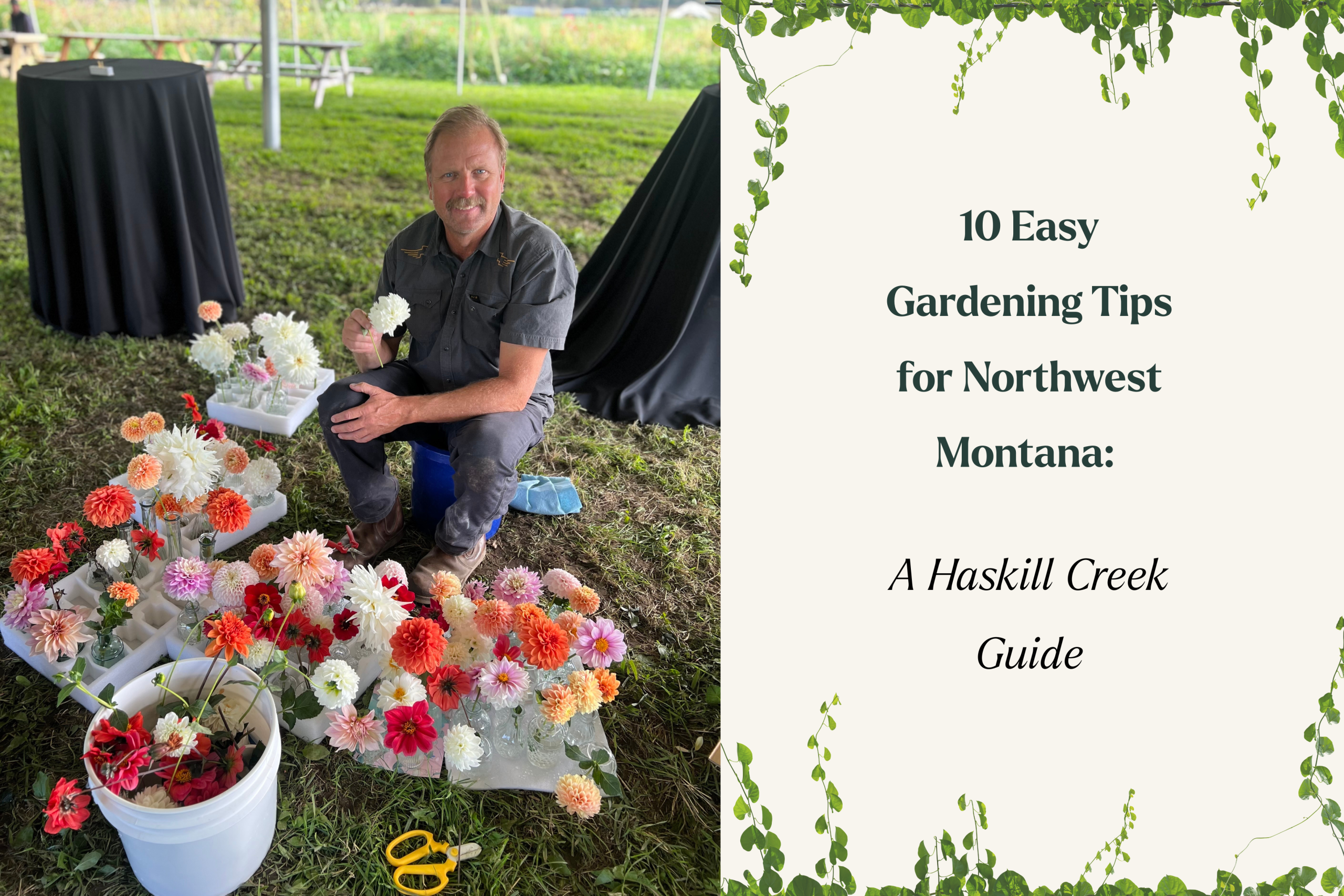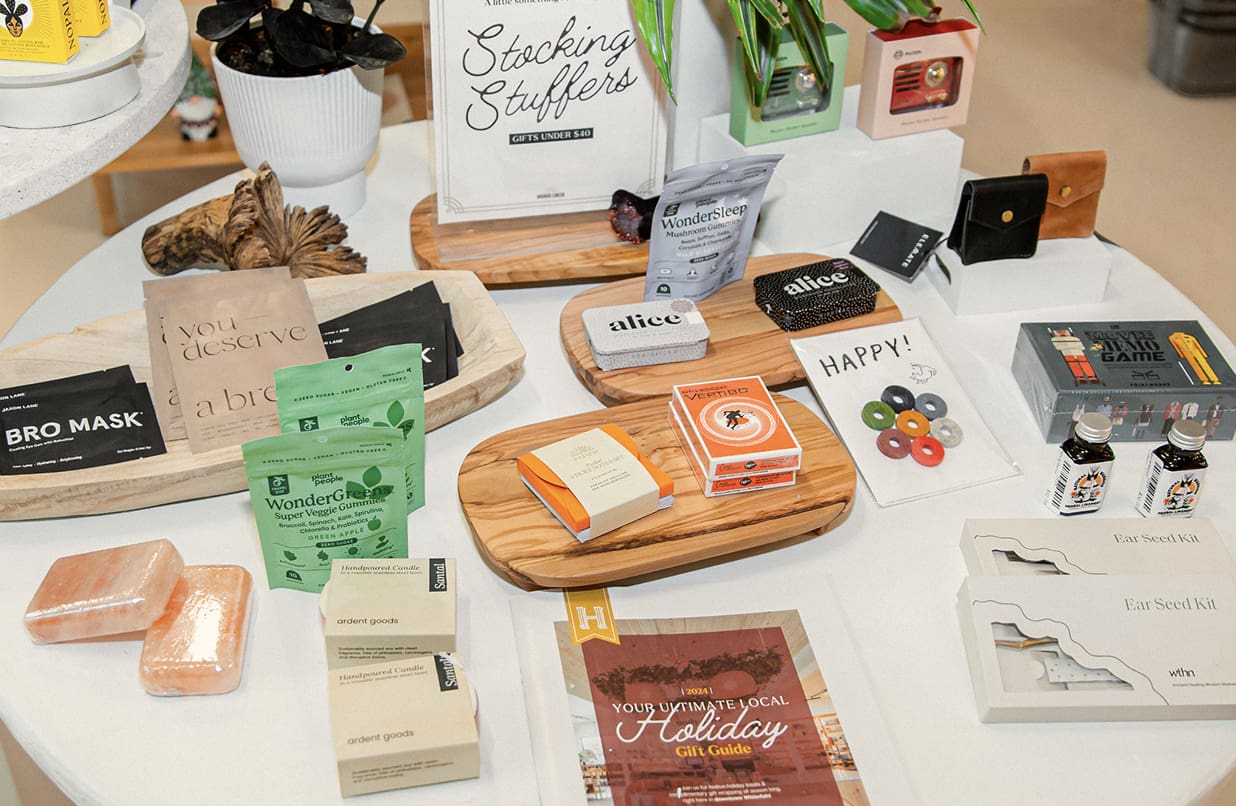Your Bag


Gardening in Northwest Montana can feel like a challenge—but with the right know-how, you can create a lush, productive garden even in our short growing season. We sat down with our Farm Manager, Jason Boyes, at Haskill Creek, who brings a wealth of experience from industrial agriculture in eastern Montana to organic hemp farming and flower cultivation right here in Whitefish. Here are his top insights for making the most of your growing space.
Whitefish, MT is located in USDA Hardiness Zone 4b. This means we see average annual minimum temperatures of -25 to -20°F. Our growing season is short, so planning is key. Starting seeds indoors and knowing when to transplant is crucial.
Didn’t start your seeds yet? That’s OK! You can buy plant starts at ACE or local nurseries like Fischer’s Garden or Hoopers.
Starting seeds indoors near a sunny window is a great way to get ahead, but be sure to cold-harden your seedlings before planting them outside. That means gradually exposing them to the cold so they can adjust without shock.
Given our climate, make sure your outdoor growing space is south-facing whenever possible. Sunlight is essential for success in this region, especially early in the season.
One of the most common mistakes? Overwatering. Raised beds can dry out faster than in-ground gardens, but it’s still important to soak deeply and less frequently rather than sprinkling daily. Always irrigate the soil directly—not the leaves—to avoid mildew and other issues.
Compost is your best friend. Whether you're amending last year’s soil or using bagged soil, mixing in compost boosts microbial life and improves structure. Jason also recommends OMRI-listed mycorrhizae in seed trays and soil to support healthy root development. (Here’s the one he uses)
This is a technique that Jason swears by, and by looking at the plants he takes care of–I have to say, I agree! So, what are LABs, and how do you make them yourself?!
Lactic Acid Bacteria (LAB) are beneficial microbes that enhance nutrient availability and promote a robust microbial ecosystem in your soil. Cultivating your own LAB is straightforward and inexpensive… Here's how:
Step 1: Prepare a Rice Wash
Rinse a cup of rice with water, collecting the milky water in a jar. This rice wash provides carbohydrates that attract beneficial bacteria.
Cover the jar with a breathable material like cheesecloth to prevent contaminants, and place it in a shaded area for 1–2 days.
Once you observe a sour smell and three distinct layers forming, extract the middle layer using a syringe or siphon, being careful not to disturb the other layers.
Step 2: Feed the LAB
Mix the extracted liquid with milk at a 1:10 ratio (e.g., 10 ml of liquid to 100 ml of milk). Use the least processed milk available, avoiding lactose-free options.
Pour the mixture into a container with an airlock to maintain an anaerobic environment. If an airlock isn't available, use a jar with a loosely fitted lid, releasing pressure periodically.
Allow the mixture to ferment for about a week. You'll notice curds forming on top and a yellowish liquid (whey) beneath.
Step 3: Harvest and Store
Strain out the curds, retaining the liquid whey. The curds can be composted.
For short-term use, store the whey in the refrigerator for up to a week.
For long-term storage, stabilize the LAB by mixing it with an equal amount of molasses (1:1 ratio). This mixture can be stored in an airtight container for up to six months.
Application:
Dilute the LAB solution at a rate about ⅓ cup of LAB to 1 gallon of water.
Apply this mixture to your garden soil or houseplants to enhance microbial activity and nutrient uptake.
By integrating LAB into your gardening routine, you're adopting regenerative practices that support soil health and sustainability.
Some vegetables thrive here and can be preserved through pickling or freezing, helping reduce waste. Great options for Northwest Montana include:
Root vegetables: carrots, beets, parsnips
Leafy greens: romaine, Bibb, and butter leaf lettuces
Others: Garlic chives, rhubarb, peas, beans, onions
Be aware that brassicas (like kale) and herbs like basil and cilantro can bolt quickly in heat
We all know the temperature can drop suddenly. Be ready to protect your plants with burlap, sheets, or plastic covers when a cold snap hits. A little preparation goes a long way.
Avoid chemical salt fertilizers, which can degrade soil health and harm the environment. Stick with compost, LABs, and other organic, regenerative inputs that nourish rather than strip the soil.
At Haskill Creek, we're passionate about regenerative agriculture—not just on the farm, but in backyards, balconies, and raised beds across Montana. Practices like composting, avoiding synthetic inputs, feeding the soil microbiome with LABs and mycorrhizae, and keeping living roots in the soil all contribute to a healthier planet. These small home-scale steps mirror the bigger mission behind our nonprofit, SaveFarmland.org, which is committed to preserving farmland and supporting regenerative farming practices.
By making conscious choices in how we garden—from the seeds we plant to the soil we tend—we can each play a part in restoring ecosystems, building soil health, and creating more resilient food systems.
Gardening in Whitefish requires planning, observation, and a few clever techniques—but it doesn’t have to be complicated. Whether you’re growing herbs in a windowsill or cultivating a backyard full of flowers and food, start with healthy soil, the right sunlight, and a little local wisdom. Happy planting from all of us at Haskill Creek!
This summer Jason is working on cultivating a beautiful crop of Dahlia’s at the farm. If you’re interested in purchasing them mid-summer for your home or an event, please email [email protected].

Join to get the Haskill Newsletter and be the first to learn about new products, events, and other goings-on at Haskill Creek!
